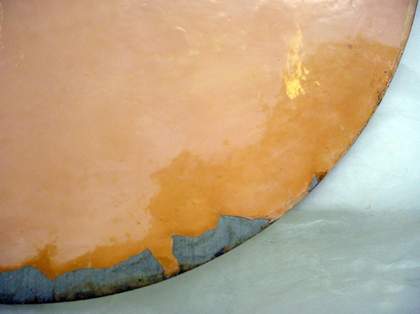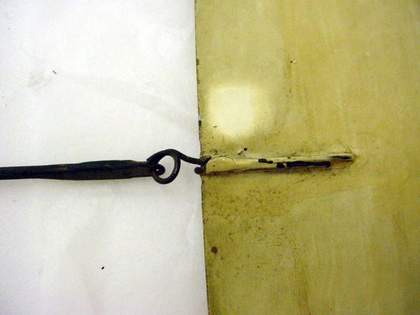Understanding the sculpture before restoration begins

Detail showing condition before treatment
To restore a work of art to their original condition, it is essential to know what the artist’s original intentions were. This is made more difficult when no images exist of the artwork in its original form and the artist is no longer alive. In the case of Kenneth Martin’s Mobile Reflector 1955 this meant thorough, detailed examination and analysis of the work, research into Martin’s methods and into other similar or contemporary works, and interviewing his family, assistants and collectors of his work.
Study of the work raised a number of wide-ranging questions. Even the title was uncertain, having been recorded variously as Reflector Mobile and Mobile Reflector. Structurally the main questions for conservators were why some areas of the piece seemed to have yellowed and why some parts of it clashed against each other when it moved.

Detail showing condition before treatment

Detail showing condition before treatment
Why some areas of the piece appeared to have yellowed?
The mobile was extremely dirty and cleaning tests showed that a water-soluble yellowed coating had been applied to some of the surfaces. FTIR analysis (Fourier Transform Infrared Spectroscopy) showed it was the type of gum used in watercolour painting. The question to ask was: had this been applied by the artist or had the coating been applied later to brighten the surface? Detailed examination revealed dirt was trapped beneath the coating suggesting the gum was a later addition. Discussions with both the artist’s son Paul Martin and his assistant Susan Tebby provided further evidence that it was unlikely the coating was applied by the artist. Removal of the coating revealed paint colours which matched those found on uncoated areas and resulted in a reintegration of the colours on the piece.
Why did parts of the mobile clash against each other?
Parts of the sculpture clashed against each other when it moved. The previous owner’s daughter, and Paul Martin, the sculptor’s son, recalled the piece as hanging with vertical bars with none of the parts touching when left to turn freely. Close examination of the clashing elements when hanging showed that one link was different from the others, possibly weighing less than the others. This seemed the likely cause of the imbalance and resultant clashing. Conservators hung cotton strips over the piece in a variety of places in order to establish the minimum weight needed to re-balance the piece; 3.14 grams were added to the left side and 3.37 grams to the right side of the second horizontal bar. For a permanent solution two thin strips of lead of the correct weights were curled round the bar and painted black to blend in with the bars. These could be slid back and forth to finely balance the piece.
Once re-balanced, cleaned, and with the paint losses retouched, this characteristic example of Kenneth Martin’s early work was finally ready for display.
References
Kenneth Martin: The Chance and Order Series, Screw Mobiles and related works, exhibition catalogue, Annely Juda Fine Art, London 1999
Kenneth Martin : Chance order change [constructions and drawings], exhibition catalogue, Galerie Artek, Helsinki 1983
